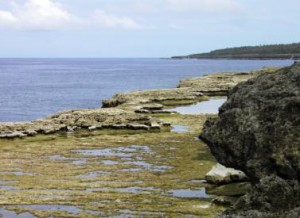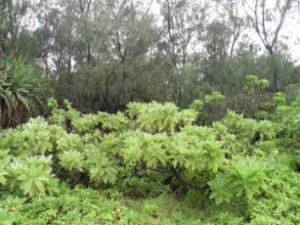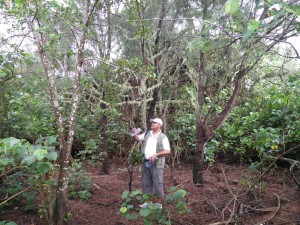Coastal Reforestation in Tonga to Protect Agricultural Areas and Coastlines
Location
Houma, southwest Tongatapu Island, Kingdom of Tonga
The challenge
In large areas of Tonga, most of the original forest cover has been removed for timber, firewood or agricultural expansion. Tongan farmers traditionally protected coastal forests as a buffer between their farms and the sea to reduce salt spray, saltwater intrusion, and wind damage from storms and cyclones. However, during the past 25 to 50 years, these forests have been cleared to extend farms seaward and take valuable timber. The deforestation has exposed shorelines, accelerated coastal erosion, reduced suitable timber for construction and firewood, and resulted in the loss of medicinal, handicraft, and other useful plants.

The project site was Houma (southwest Tongatapu): a rocky, uplifted windward limestone area, with a raised limestone terrace and a fringing coral reef that drops off to the deep ocean. © Randy Thaman
This was particularly serious around Houma on the southwest coast of Tongatapu, the largest and most populated island in Tonga, where farms and grasslands expanded towards the coast, and traditional agroforestry trees were removed. Cattle, horses and especially pigs, and the indiscriminate use of fire to prepare gardens have also damaged these forests. These losses have resulted in drastic declines in agricultural productivity and associated biodiversity; some farms have been abandoned due to the increased wind and salt spray.
The coastal lands of many other small island states are seriously threatened by coastal erosion and increasing salination, which are exacerbated by rising sea levels. The erosion can be particularly serious if the natural coastal vegetation has been removed, which leads to seawater contamination and increasing wind damage to coconut plantations, food gardens and particularly, to freshwater wells. Accelerated erosion also damages nearby coral reefs.
Actions taken
The Tonga Coastal Protection and Reforestation Project was implemented by the Ministry of Agriculture and Forestry (MAF) and partners in the mid-1990s to address these problems. The primary objectives were to: develop and implement an effective model for coastal reforestation near the Blow Holes at Houma, and develop effective community-based programs to promote coastal reforestation and protection at community and landowner levels.
As a first step, the MAF assessed many indigenous coastal species to find the best local trees and shrubs to plant along the coastal zone. They examined previous propagation projects looking for salt- and wind-tolerant plants, particularly important food and timber trees, or other trees with cultural significance such as those that are used medicinally or for woodcarving. Some of the species selected and used include: Casuarina equisetifolia which is successful as a windbreak, coconut palms, Pandanus tectorius, Hibiscus tiliaceus, Excoecaria agallocha, Calophyllum inophyllum, Hernandia nymphaeifolia, Terminalia catappa, Tournefortia argentea, Barringtonia asiatica, and Neisosperma oppositifolium. Other indigenous species that show promise for enrichment include the high-value carving wood and multi-purpose trees, Thespesia populnea, Cordia subcordata, Guettarda speciosa, Xylocarpus moluccensis, and sandalwood (Santalum yasi), which have all been historically selectively removed from Tonga’s coastal forests.
The project site was then marked out and manually cleared to remove Guinea grass (Panicum maximum) and other shrubby vegetation in order to reduce wild fires, which damaged previous re-vegetation projects in Tonga. A 5 m wide firebreak was cleared along the land side and planted with cassava (manioke) and other crops to keep out the Guinea grasses and prevent people from trampling or driving over the young trees.

View of plants double row Casuarina windbreak on inner margin of the reforestation area forest. © Randy Thaman
A three-phase approach was used for reforestation: First, fast-growing pioneer species were planted to provide shade and shelter from the wind, with Casuarinas planted in two staggered rows five meters apart on the land adjacent to farms. Large numbers of Casuarinas can be grown easily from seed; they fix nitrogen, are useful as firewood and grow rapidly to form effective wind breaks. Thirty different native coastal tree species were also planted on the seaward side of the Casuarinas. Secondly, after about 6 months, less-tolerant, but preferred species were planted in the shelter of the pioneers. Finally, they focused on hard-to-propagate species to increase diversity matching that of the original forest.
A concerted awareness-raising program on coastal reforestation was also implemented with the local community. The program focused on the need for maintenance of the newly planted trees. This included: frequent weeding to prevent overgrowth by grasses, shrubs and vines and to reduce the fuel for wildfires and the maintenance of firebreaks; the protection of pre-existing mature trees within the planted area; and control of free-ranging livestock, particularly pigs, cattle and horses.
How successful has it been?
The coastal reforestation project in Houma was very successful in re-establishing a viable forest and windbreak. By 2011, the forest was fully grown with the double row of Casuarinas forming a wall along the coast and protecting the farms and many other coastal trees in this multi-species forest.
- About 25,000 seedlings and saplings from 30 indigenous species were planted along 2 km of coastline in 2.4 hectares, mostly in a narrow band 12 m wide.
- Approximately 80% had survived after 2 years, which was more than had been expected and a credit to community-based management of the project.
- Cyclone Hina in March 1997 caused no damage to trees, except snapping off the upper crown of some Casuarinas.
- The community played a very positive and critical role in the project through preparing, planting, and maintaining the site.
A limiting factor for reforestation on Tonga is the legal definition of the coastal area, “the area between high tide and 50 feet (15.4 m) inland,” but local boundary markers can vary considerably. This is virtually the only land owned and controlled by the Government; thus part of the Houma site was within the coastal zone, and the rest within the estate of village chiefs. No reforestation land was in farmers’ allotments, but the coastal forests were considered to be common property for firewood, medicinal plants, wood for carving and building. Thus the agreement from the community and chiefs to the tree planting project and allowing the forest to grow was and remains a critical factor to project success.
This project has shown that coastal reforestation is a very feasible and practical activity for communities to protect their land from sea-level rise, climate variability, and extreme events (such as tsunamis and cyclones).
Lessons learned and recommendations
- Coastal forest protection should be a high priority for small island communities, particularly with the threat of sea level rise and increasing extreme events. Protecting original coastal forests is easier and more cost-effective than re-establishing a degraded forest
- Using local salt-tolerant species is a cost-effective, low-tech method for coastal reforestation to protect coastal lands and communities from natural disasters and sea-level rise, and to increase food production and promote livelihood security
- Involving traditional leadership and identifying a ‘champion’ to raise awareness in communities for a project can enhance success. The project was proposed by the traditional chief from Houma (who was also the Prime Minister) which greatly increased stakeholder buy-in to the effort from the beginning
- National legislation is needed to support community projects in the coastal commons to reduce coastal forest degradation, shoreline erosion, reduce sedimentation on reefs and to protect threatened marine and land animals, such as sea turtles, sea birds and land crabs, for which coastal littoral forests are their main habitat
- Before starting, it is essential to understand traditional ownership rights and customary (‘usufruct’) rights to resources on common land
- Planting cassava and other food crops in the fire break was successful because people were able to use their labor to reduce the fire threat through weeding while at the same time growing valuable crops
- Selecting the most appropriate multipurpose trees is important to gain community support, this project used over 30 indigenous species all of which are culturally valuable in Tonga
- Coastal reforestation is a long-term effort. It is critical when designing a coastal reforestation project to provide enough time to allow a three-phase coastal reforestation (pioneer species, non-pioneer species, and high forest biodiversity enrichment planting). Short-term projects often fail, which results in a lack of confidence and support from local communities
- Regular maintenance is essential to prevent grasses, weeds and smothering vines, and to reduce the amount of fuel for fires. This was done by the Forestry staff who were assisted by the Houma community
- Protection from free-ranging livestock is essential and may require fencing
- Coastal reforestation is a very practical activity for communities to protect their land from sea-level rise, climate variability and extreme events (such as tsunamis, cyclones and excessively high tides and waves
- Protecting original multi-species coastal forests is easier and more cost-effective than re-establishing or enriching a degraded forest
Funding summary
Secretariat of the Pacific Regional Environmental Program – $10,000 (US)
Lead organizations
Tonga Ministry of Agriculture, Fisheries and Forestry
Contacts
Randy Thaman, University of the South Pacific, Fiji; thaman_r@usp.ac.fj
Andrew Smith, WWF, Australia; asmith@wwf.org.au
Tevita Faka’oso, Forestry division, Kingdom of Tonga; foresto@kalianet.to
Partners
Australia Aid (AusAid)
Secretariat of the Pacific Regional Environmental Program (SPREP)
The University of the South Pacific
The Nature Conservancy
The Houma local community
Resources
This case study was written by Randy Thaman, Andrew Smith, and Tevita Faka’osi, Case Study #22 from the following publication: Wilkinson, C., Brodie, J. (2011). Catchment Management and Coral Reef Conservation: A Practical Guide for coastal Resource Managers to Reduce Damage from Catchment Areas Based on Best Practice Case Studies (pdf). Global Coral Reef Monitoring Network and Reef and Rainforest Research Centre Townsville, Australia, 120 P.



